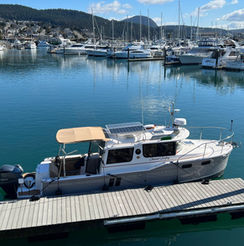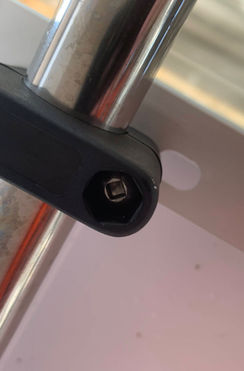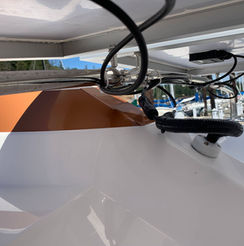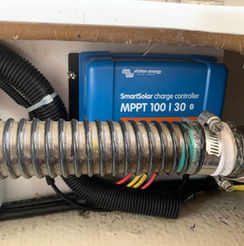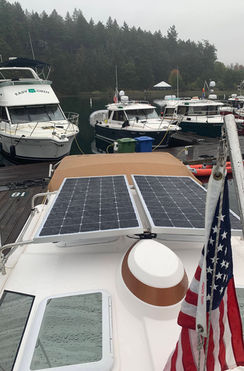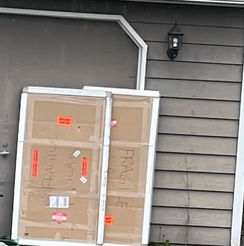
Solar Panels
Upgraded to 420 watts of Solar. The silent genset.
I upgraded our solar to 420 watts.We now have our energy independence during boating season. I have seen as high as 30 amps going to the house bank from solar.
Being Pacific Northwest boaters, I wasn't a believer in solar before, I am now! We no longer require shore power when at a guest marina during boating season. We are seeing over 2,000 watt-hours a day (about 166 amp-hours, daily). I've seen as high as 2,730 watt-hours (213amp-hours) in a day. Our normal daily consumption is around 1,200 watts-hours (120amp-hours). In September, at Roche Harbor, it rained all day. We still captured 590 watt-hours (49 amp-hours).
For the Pacific Northwest, use the following formula: Watts / 4 = amp-hours a day. Example: 420 watts / 4 = 105amp-hours a day. This is an annual average. Expect to see about double that in the summer time, and half that in the offseason. Don't count on Solar in November - February.
It's also important to note that we are heavy heavy users of electrical. I work from the boat. We use what we want, however, we turn things off we aren't using.
Solar Upgrade
I removed the factory 160 watt polycrystalline panel.
I installed a pair of Custom Marine products 210 watt 23.7% efficient (Sunpower mono crystalline) marine grade solar panels. (They are the same width as the factory panel, and about 3 inches shorter!)
I ran 15' of #6 awg from the house battery to a 40amp fuse to the solar controller.
I upgraded the factory PWM solar controller to a Victron MPPT SmartSolar 150/35 controller.
The 12volt red/yellow pair of wire that went from the solar controller to the engine battery are no longer used so I pulled the fuse on them and labeled the ends NIS "Not In Service". I also disconnected them from the engine battery. I don't want lose wires laying around waiting to short out.
I connected the port and starboard solar panels in series (not parallel). I have no shading problem up top, and I wanted the amps to remain low, and the voltage to go high (around 70 volts DC).
As an added bonus... the clamp-on stainless brackets I used (Gemini Products) look great and hold the panels up off the roof rack about 2 inches higher. This provides more clearance for opening the aft hatches. The solar panels cover the aft hatches entirely, so if it's raining out, we can still open those two hatches without water running in.The big con to this upgrade, I have little room up on the roof rack for a kayak or anything else to store. Having enough power was more important to us.
I looked at a portable generator and decided against one. They are noisy in quiet anchorages. They present a carbon monoxide poising risk to all onboard. Running it on the transom, surrounded by saltwater, it would most likely prematurely rust. Plus, it's another piece of gear to carry around and perform maintenance on. Our 420 watt solar array is our generator.
If you're looking to upgrade your house battery bank, consider upgrading to solar first. You may find that you won't need as large of a battery bank.
The installation is mostly comprised of mounting the panels. The electrical work was minor. I will note, always upgrade the solar controller first to ensure compatibility with whatever solar panels you go with.
I purchased the following:
(2) 210 Watt Custom Marine mono-crystaline solar panels. Part No. CMP22200S-210
Total cost of the upgrade was about $2,400 and was a full day of labor.
5/28/2021
Last updated: 1/5/2025






